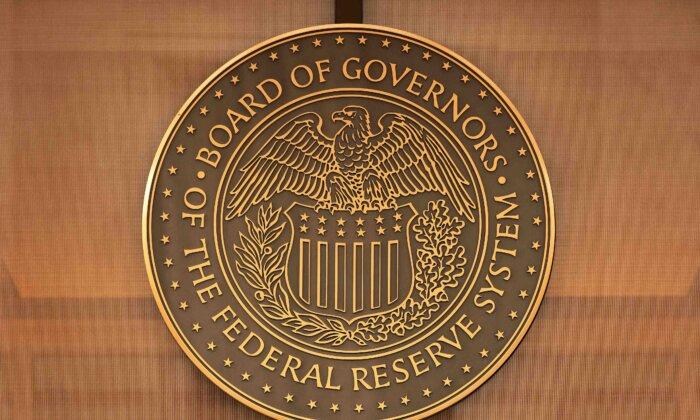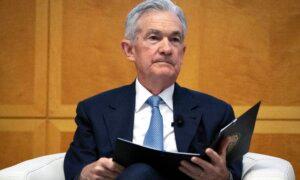Last Oct. 19 was the anniversary date of the big stock market crash of 1987, and there was certainly a lot of gloom in the air on that Thursday, the 19th. The stock market had been falling since July 31 and the 10-year Treasury yield was approaching 5 percent. It took another week for the stock market to bottom out, but the decline in the 10-year Treasury rate is what led stocks back up, as the 10-year Treasury rate plunged to 3.83 percent intraday last Thursday! As this trend continues, with the Federal Reserve pledging to make three (or more) rate cuts in 2024, growth stocks are gearing up to explode to the upside in the New Year.
The Fed’s Favorite Inflation Indicator Says ‘Mission Accomplished’
First, let me revisit the inflation news: Consumer prices are falling around the world. China’s National Bureau of Statistics, for example, reported that its consumer prices declined 0.5 percent in November, reaching the fastest 12-month decline in three years. Germany’s consumer price inflation also declined 0.3 percent in November. That means our imports from China and Germany are falling in price, which contributed to the Producer Price Index (PPI) declining 0.8 percent and rising only 0.9 percent in the past 12 months.And now, last Friday, the Federal Reserve’s favorite inflation indicator—the Personal Consumption Expenditures (PCE) price index—was released, which declined 0.1 percent in November, the first monthly decline since April 2020. In both October and November, the core PCE, which excludes food and energy, rose only 0.1 percent. In fact, the core PCE is running at a 1.9 percent annual pace over the past six months, so the Fed’s 2 percent inflation target is finally within sight, if not fully accomplished. The Fed can now finally say, “Mission accomplished.”
That’s probably why the Fed so clearly pivoted from “higher for longer” to “rate cuts sooner than later” at its mid-December policy-making meeting of the Federal Open Market Committee (FOMC), in which they revealed that their “dot plot” from 17 FOMC voting members revealed an expected three rate cuts in 2024. Furthermore, these Fed officials also anticipated three to four more rates cuts in 2025, taking the key Fed funds rate to a range of 3.5–3.75 percent. However, if the Fed wants to stay in good graces with the president (and also say that they are “staying out of politics”), they might make all six or seven 25-basis-point rates cuts before the November presidential elections, super-charging the economy, plus consumer and investor sentiment.
In other economic news, Santa Claus is also alive and well: Real disposal income rose 0.4 percent in November, the fastest monthly rise since March. Consumer spending rose 0.2 percent in November, up from 0.1 percent in October. This latest data bode well for strong consumer spending through this holiday shopping season.
The good news kept pouring in last Friday, when the Commerce Department reported that durable goods orders surged by 5.4 percent in November, due to a 15.3 percent surge in transportation orders. The Commerce Department also revised October durable goods orders slightly upward to a 5.1 percent decline (from the 5.4 percent decline initially reported), due predominately to a 13.4 percent decline in transportation orders. Clearly, commercial aircraft orders, which surged 80.1 percent at Boeing in November, have been dominating the monthly durable goods data. Fortunately, core capital goods orders also rose 0.8 percent in November, after declining 0.3 percent in October. Overall, this durable goods report is signaling improving economic growth.
The Commerce Department previously announced that retail sales rose 0.3 percent in November, which was substantially better than the economists’ consensus estimate of a -0.1 percent decline. Excluding vehicle and gasoline sales, retail sales rose by a much more robust 0.6 percent in November, which is better than the 0.1 percent increase in October! In the past 12 months, retail sales have risen 4.1 percent. Spending at bars and restaurants surged 1.6 percent in November, which is a good sign that consumers are out and about. Due to these improvements in the November data, we can expect an upward revision in fourth-quarter GDP estimates.
Some investors have been confused about why the U.S. economy seemed to be decelerating from a nearly 5 percent annual GDP growth rate in the third quarter to about half that level, an estimated 2.7 percent GDP growth in the fourth quarter. The biggest change is inventories, since there was a big inventory rise in the third quarter, just before the holiday shopping season. Typically, inventories are depleted during the holiday shopping season. Furthermore, energy prices have fallen slightly, so the robust GDP growth in the third quarter from the exports of liquefied natural gas, crude oil and refined products slowed just a bit in the fourth quarter.
Rising Global Tensions Should Help Energy Stocks in 2024
The year ahead still contains some wild cards. There have now been over 100 attacks on U.S. military facilities and ships in the Middle East since Hamas attacked Israel on Oct. 7. The Iran-backed Houthi rebels in Yemen have been very aggressive in trying to hit the USS Carney and USS Mason, as well as the British Navy ship HMS Diamond, in what some are calling a game of “Battleship.” Obviously, Britain and/or the United States will have to respond decisively, otherwise they are just encouraging more attacks by Iranian proxies. Due to escalating attacks in the Red Sea, commercial traffic is now being diverted.The price of some consumer goods could rise if these shipping disruptions persist. Last week, the United States announced a 10-nation force to combat the Houthi attacks on ships in the Red Sea. Those nations include vessels from Bahrain, Britain, Canada, France, Italy, the Netherlands, Norway, Seychelles and Spain.
In another war that is now nearly two years old, Ukrainian President Volodymyr Zelenskyy has vowed to mobilize 500,000 troops for a counteroffensive with Russia. The problem is that both Russia and Ukraine are running out of troops to fight that war of attrition. The war has been an incredible tragedy for all involved. I suspect that Mr. Zelensky will not be able to mobilize 500,000 men. In the meantime, Russia is losing 1,000 men per day as it maintains attacks on six fronts. This is a war of attrition that both sides are losing.
I have reported on Ukraine’s apparent attack on the Trans-Siberian Railway in two locations deep in Eastern Russia, designed to hinder trade between Russia and China. Ukraine has not taken responsibility for the attack.
Recently, I also reported on a new potential war front, in which Venezuela asked its citizens to vote to take over approximately two-thirds of Guyana, which is the hottest crude oil producer in Latin America and “the fastest offshore oil development in the history of the world,” according to energy expert Daniel Yergin. Approximately 95 percent of 10.5 million voters in Venezuela approved of this territorial theft.
These wars in oil-rich areas are just some of the reasons why I believe it is imperative to hold on to energy stocks, since not only is the United States producing an all-time record crude oil and natural gas but in the event of 1) another pipeline incident in Russia, or other rising tensions in Russia, or 2) more ships being diverted in the Middle East due to relentless attacks in the Red Sea, or 3) Venezuela seizing parts of Guyana, energy stocks are a hedge to protect portfolios in case of rising global tensions.
Presidential Election Years Are Also Positive for Stocks
I should add that presidential election years are also typically positive for the stock market, since the candidates typically run around and promise us everything and anything. President Joe Biden obviously cannot campaign like the other candidates, so he will be underwriting a lot of Super Bowl ads to make his pitch.Since onshoring largely failed for a big semiconductor plant in Arizona (scheduled to open in 2025) and multiple electric-vehicle battery plants in Michigan and other states were canceled due to a lack of demand, some key elements of Bidenomics have failed. Since the U.S. manufacturing sector has contracted for 13 straight months, according to ISM, many swing states like Arizona and Michigan are now up for grabs.
Around the world, the candidates that are winning are largely “upstarts with big hair,” like Argentina’s Javier Milei or the Netherlands’ Geert Wilders. So that essentially means that the next U.S. president could be Gavin Newsom, Nikki Haley, Vivek Ramaswamy, or Donald Trump. Furthermore, the winning candidate may not get 50 percent of the vote due to Robert F. Kennedy, Jr. running as an Independent. If history repeats, the stock market should rally right up to the November election, aided by endless campaign promises as well as multiple Fed rate cuts. As a result, I am expecting a very prosperous new year!
Speaking of Argentina’s new president, Javier Milei, he took the first step to privatize government-run companies last week, with a sweeping decree that opens the door for private businesses to take control of these government-run operations. In a televised message, Mr. Milei said, “Repeal rules that impede the privatization of state companies.” Specifically, the Argentina national airline, rail networks, state media companies, water and sewage companies are all expected to be taken over by private entities. Argentina’s energy company, YPF, may take up to two years to privatize, since it is more entrenched and requires two-thirds approval by Congress to sell its government-owned shares, due to a 2012 nationalization law.
S&P 500 Index earnings are now at an all-time record high, and earnings will be accelerating for the next three quarters due to favorable year-over-year comparisons. Several companies announced share buybacks or special dividends. In other words, many companies are literally throwing money at shareholders. So, barring something catastrophic like another pandemic to disrupt presidential voting, or a flare-up in one of the multiple wars (e.g., Ukraine, the Middle East, and now, potentially, Venezuela) that the United States is involved with around the globe, the market should do well. Since the United States has the lowest troop level—1.3 million—since before World War II, we have to be careful about any new conflicts we get involved in.
Fortunately, most national leaders (except those within Hamas) realize that wars are futile. Even Russia now realizes that war can be problematic, after losing 315,000 troops and much of its military readiness. Although I realize that anything can happen, I want you to know that short of a mushroom cloud blowing up above part of the world, the stock market is likely to soar! Due to falling Treasury yields, easy year-over-year earnings comparisons, an accommodative Fed, resurging economic growth, growing U.S. energy production, and presidential candidates promising prosperity, I expect the market to explode to the upside! Why else would some of our companies buy back 20 percent of their outstanding stock or pay extraordinary dividends?
In summary, I recommend investors use these final few trading days of the year to get fully invested before an anticipated January surge. January is often characterized by strong trading volume, so if we could surge on light trading volume in recent holiday weeks, then we could potentially surge 15 percent or more in January. Then, starting in late January, I expect wave after wave of better-than-expected fourth-quarter earnings for the growth stocks, sending them soaring!







